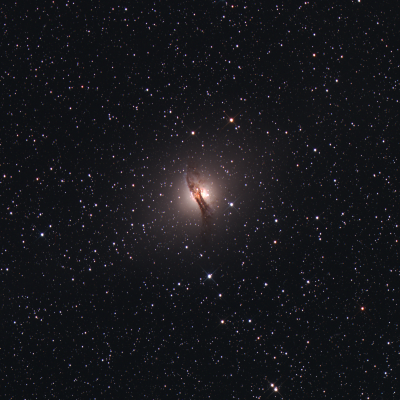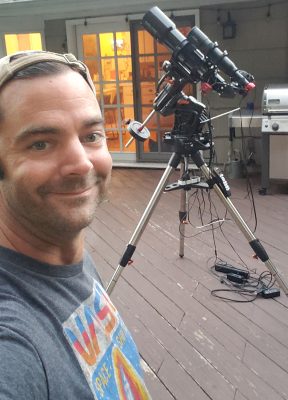Local Astrophotographer’s Work Shines at the Black Cow — and It’s Truly Out of This World
News Based on facts, either observed and verified directly by the reporter, or reported and verified from knowledgeable sources.

By Elaine Clarke
Scott Canoni has always had a love for space. Now, he’s loving taking pictures of it. After shifting from full-time to part-time work as a software engineer, he began researching astrophotography — the photography of outer space — in his free time.
“It’s a complex, but fun, scientific hobby,” he said. “I’ve been doing that for at least two and a half years now, actively taking pictures.”
The culmination of his two years of work is being showcased this July at the Pleasantville Black Cow. The café walls currently display 22 different metal prints — some of Canoni’s favorite pieces and others from the James Webb Space Telescope — to compare different coloring methods in astrophotography. Canoni’s work features all true-color photos, which reflect what you can see with the naked eye.
Photographing Space

Canoni explained that astrophotography involves taking as many pictures as possible of a specific target.
“Let’s say the Andromeda Galaxy, for example,” Canoni said. “I will take hours of photos of that target, and then will stack those photos later to essentially capture the light as best as possible and remove noise.”
Noise, Canoni described, is anything that gets in the way of the subject.
“You have issues like satellites and clouds and even a shooting star could get in the way. You don’t want that in the final image, unless you do want it,” he said. “And then you would remove those from the stack and there’s software to help you.”
Astrophotography is a very delicate science — Canoni emphasized that you have to be perfectly aligned with your telescope. As part of his setup, he uses two.
“That secondary telescope is attached to the first one as a guide scope,” he explained. “If that doesn’t work well, then your stars are not perfectly round. You get little trails and you don’t want that, so you get bad data in that regard.”
He also has to be careful not to shake his camera out of alignment. Canoni uses a long USB cable that runs inside so his porch remains undisturbed.
From his porch, Canoni can see much of the sky, taking pictures straight up to avoid trees and the turbulent atmosphere along the horizon. On a given night, Canoni will photograph two to three targets, repeating the process each night until he gets the desired data. His targets include anything visible in the night sky — the Andromeda Galaxy, the Orion Nebula, or even the moon.
“Although you want to take pictures of deep space objects when the moon is not in the sky,” he explained. “I have a lot of friends and family who contact me saying ‘The moon is so beautiful tonight’ and I’m like, ‘Yeah, I know it’s in the way.’”
While taking photographs of subjects that are millions of light-years away is incredibly complicated, Canoni’s biggest problem is right here on Earth — light pollution.
“The light pollution requires me to take more photos for longer periods of time to counteract that noise,” he said. “If you’re in a darker sky, you can take less photos and capture just as good quality. I have my work cut out for me here in Chappaqua.”
Canoni explained Chappaqua is a Bortle five area — a nine-level scale that measures the night sky’s brightness in a given location. To find darker skies, he sometimes travels to places like Cape Cod. But even that is becoming difficult as light pollution continues to worsen.
Getting the Perfect Shot

In order to get the perfect picture, Canoni said, several different factors come into play: the noise, the shape of the stars, the range of colors — even how black the background is.
“Doesn’t have to be a pure black for space, but I think it’s helpful to show that there’s nothing there,” Canoni said.
He also considers the framing of his subject.
“You can point at the middle of it or you can give it a little off center, just to help with a two thirds angle like you do in photography,” he explained.
In addition to his work in Chappaqua, Canoni pays to remotely take photos in Chile, Australia, and Utah — all incredibly dark sky locations.
“It’s so cool with the remote astrophotography, because I’m able to capture things in the Southern Hemisphere that I could never even see up here,” he said.
Space on Display
Canoni said it’s incredibly rewarding to have his work on display. In January, he had his first show at the Irvington Library. That’s where an old friend from high school told him about the Black Cow.
“I emailed the owner. She said, ‘Yeah, we do this. We’d love to have you up,’” he explained. “They’re so nice there. It’s such a wonderful service to the community that they’re doing to allow me to put my art photos up in their business and have others see it.”
Canoni described one instance when he and his wife went to get coffee incognito and saw a man asking the baristas questions about his art.
“He asked some in-depth questions that they didn’t know and I stepped in. It was just so rewarding to just share the process because people have all these questions about how you create it,” he said. “I just want to keep capturing photos and sharing them, because that’s the best part about this hobby, is sharing them with everyone and teaching them about it.”
Canoni will be exhibiting his work at the Armonk Library in November and at the Mount Kisco Library in December, in honor of its 150th anniversary. He also sells his work online through Etsy and Shopify. Eventually, he hopes to showcase his photography at art exhibits and fairs.
Although Canoni has a sophisticated setup, he stressed that anyone can try astrophotography.
“When you’re in a dark sky location, just put your cell phone on the picnic table, set it to a long exposure of 30 seconds,” he said. “And you’ll get something.”

Examiner Media – Keeping you informed with professionally-reported local news, features, and sports coverage.
